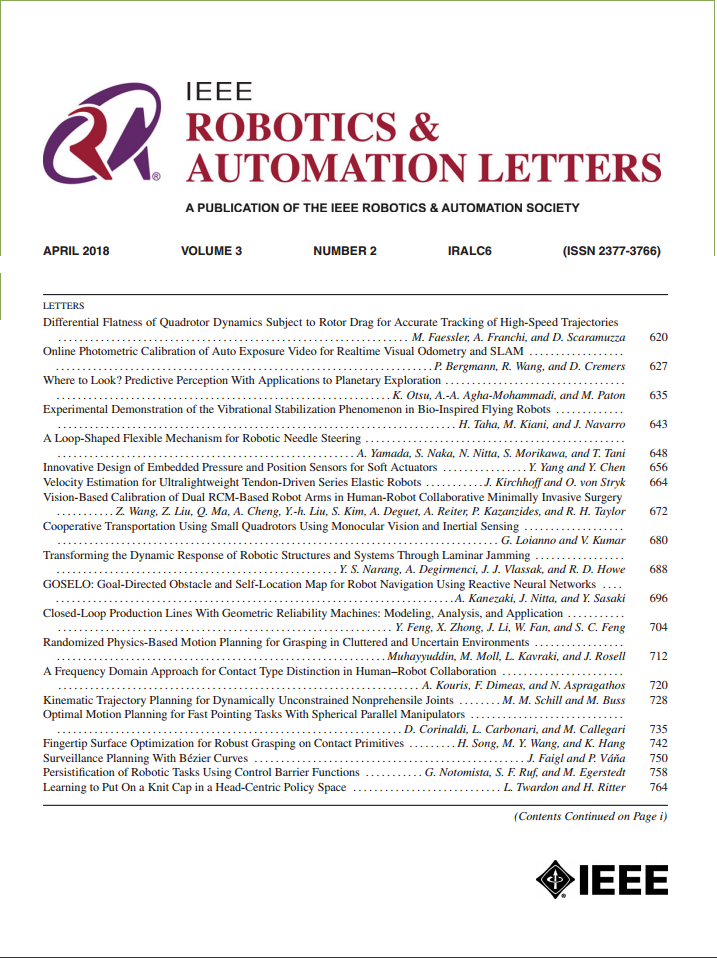Sensor-Free Strategy for Estimating Guidewire/Catheter Shape and Contact Force in Endovascular Interventions
IF 4.6
2区 计算机科学
Q2 ROBOTICS
引用次数: 0
Abstract
Accurate assessment of guidewire shape and contact forces is critical for autonomous robotic endovascular procedures. However, existing sensor-based approaches often require modifications to standard guidewires or the use of custom-made alternatives, which can hinder integration into conventional surgical workflows and increase costs. Moreover, the sensor-based method can only obtain partial force information. This letter aimed to develop a novel sensor-free two-step computational method for estimating overall guidewire shape and forces using only routinely obtainable information. The vascular space is discretized into multiple mesh points along the centerline to form a graph. Based on an energy equation, the lowest energy path between the start point (the insertion position) and the endpoint (the guidewire tip position) is searched as the initial shape of the guidewire. This initial shape, along with the known insertion length, is then input into a finite element model to compute the final guidewire configuration and contact forces. The method was validated through 3 rounds of testing in 3 phantom models at 4 different insertion lengths. In 11 successful experimental scenarios, the estimated guidewire shapes closely matched the actual shapes, with an average root mean square error of 0.50血管内介入术中导丝/导管形状和接触力估计的无传感器策略
准确评估导丝形状和接触力对自主机器人血管内手术至关重要。然而,现有的基于传感器的方法通常需要修改标准导丝或使用定制的替代品,这可能会阻碍与传统手术工作流程的整合,并增加成本。此外,基于传感器的方法只能获得部分力信息。这封信旨在开发一种新的无传感器的两步计算方法,用于仅使用常规可获得的信息来估计总体导丝形状和力。血管空间沿中心线离散成多个网格点,形成图形。基于能量方程,搜索起始点(插入位置)和端点(导丝尖端位置)之间的最低能量路径作为导丝的初始形状。这个初始形状,以及已知的插入长度,然后被输入到一个有限元模型中,以计算最终的导丝结构和接触力。该方法通过3个模型的4种不同插入长度的3轮测试得到验证。在11个成功的实验场景中,估计的导丝形状与实际形状非常吻合,平均均方根误差为0.50 $\pm$ 0.12 mm。接触力估计的平均精度为91.9 $\pm$ 2.9%,与实测值的平均角偏差为1.94 $\pm$ 1.03$^\circ$。
本文章由计算机程序翻译,如有差异,请以英文原文为准。
求助全文
约1分钟内获得全文
求助全文
来源期刊

IEEE Robotics and Automation Letters
Computer Science-Computer Science Applications
CiteScore
9.60
自引率
15.40%
发文量
1428
期刊介绍:
The scope of this journal is to publish peer-reviewed articles that provide a timely and concise account of innovative research ideas and application results, reporting significant theoretical findings and application case studies in areas of robotics and automation.
 求助内容:
求助内容: 应助结果提醒方式:
应助结果提醒方式:


